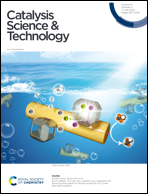N,N,O-Coordinated tricarbonylrhenium precatalysts for the aerobic deoxydehydration of diols and polyols†
Abstract
Rhenium complexes are well known catalysts for the deoxydehydration (DODH) of vicinal diols (glycols). In this work, we report on the DODH of diols and biomass-derived polyols using L4Re(CO)3 as precatalyst (L4Re(CO)3 = tricarbonylrhenium 2,4-di-tert-butyl-6-(((2-(dimethylamino)ethyl)(methyl)amino)methyl)phenolate). The DODH reaction was optimized using 2 mol% of L4Re(CO)3 as precatalyst and 3-octanol as both reductant and solvent under aerobic conditions, generating the active high-valent rhenium species in situ. Both diol and biomass-based polyol substrates could be applied in this system to form the corresponding olefins with moderate to high yield. Typical features of this aerobic DODH system include a low tendency for the isomerization of aliphatic external olefin products to internal olefins, a high butadiene selectivity in the DODH of erythritol, the preferential formation of 2-vinylfuran from sugar substrates, and an overall low precatalyst loading. Several of these features indicate the formation of an active species that is different from the species formed in DODH by rhenium-trioxo catalysts. Overall, the bench-top stable and synthetically easily accessible, low-valent NNO–rhenium complex L4Re(CO)3 represents an interesting alternative to high-valent rhenium catalysts in DODH chemistry.



 Please wait while we load your content...
Please wait while we load your content...